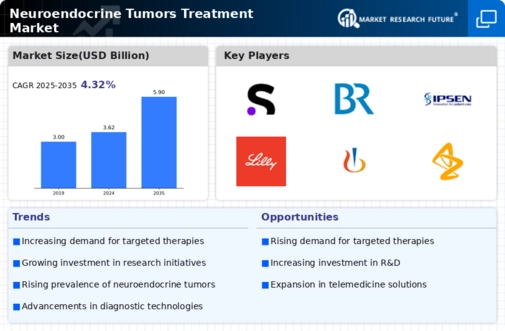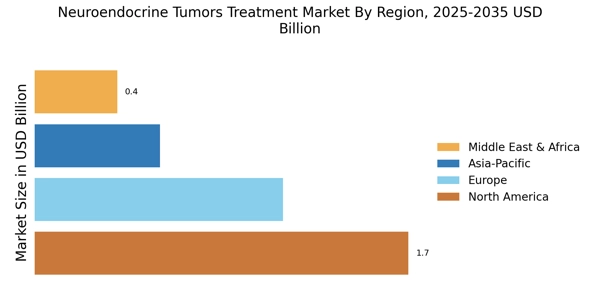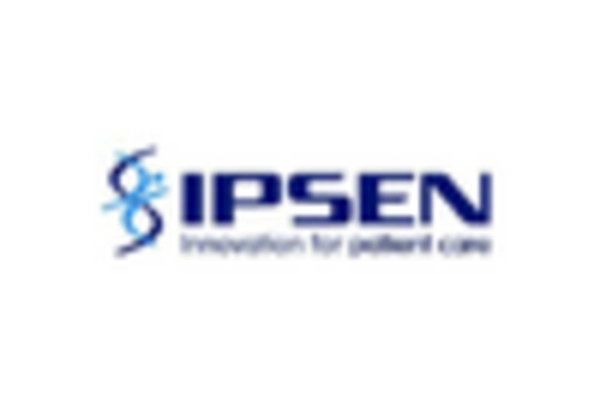Innovations in Treatment Modalities
Innovations in treatment modalities are significantly influencing the Neuroendocrine Tumors Treatment Market. The advent of novel therapies, including targeted therapies and peptide receptor radionuclide therapy (PRRT), has transformed the treatment landscape for NETs. These advancements not only enhance treatment efficacy but also improve patient outcomes, leading to a growing preference for these innovative options among oncologists. Market data suggests that the targeted therapy segment is expected to witness substantial growth, potentially reaching a market value of USD 1.5 billion by 2026. This shift towards more personalized treatment approaches reflects a broader trend in oncology, where precision medicine is becoming increasingly vital. As these innovations continue to emerge, the Neuroendocrine Tumors Treatment Market is likely to experience robust growth driven by the demand for cutting-edge therapies.
Regulatory Support for New Therapies
Regulatory support for new therapies is an essential driver for the Neuroendocrine Tumors Treatment Market. Regulatory agencies are increasingly recognizing the need for expedited approval processes for innovative treatments, particularly those addressing rare cancers like neuroendocrine tumors. Initiatives such as orphan drug designations and fast-track approvals are facilitating quicker access to novel therapies for patients. This supportive regulatory environment encourages pharmaceutical companies to invest in research and development, leading to a more dynamic market landscape. As new therapies receive approval and enter the market, the Neuroendocrine Tumors Treatment Market is likely to experience accelerated growth, driven by the availability of effective treatment options for patients.
Increased Investment in Cancer Research
Increased investment in cancer research is a crucial driver for the Neuroendocrine Tumors Treatment Market. Governments and private organizations are allocating substantial funds to advance research initiatives aimed at understanding the biology of neuroendocrine tumors and developing new therapeutic strategies. For instance, funding for clinical trials and research projects has seen a marked increase, with estimates suggesting that global funding for cancer research could exceed USD 200 billion by 2025. This influx of capital is expected to accelerate the discovery of novel treatment options and improve existing therapies, thereby enhancing the overall treatment landscape for NETs. As research progresses, the Neuroendocrine Tumors Treatment Market stands to benefit from the introduction of innovative therapies that address unmet medical needs.
Rising Incidence of Neuroendocrine Tumors
The increasing incidence of neuroendocrine tumors (NETs) is a primary driver for the Neuroendocrine Tumors Treatment Market. Recent data indicates that the prevalence of NETs has been on the rise, with estimates suggesting that the annual incidence could reach approximately 6.98 cases per 100,000 individuals. This trend is likely attributed to improved diagnostic techniques and heightened awareness among healthcare professionals. As more cases are identified, the demand for effective treatment options is expected to surge, thereby propelling the market forward. Furthermore, the growing aging population, which is more susceptible to various forms of cancer, may contribute to this upward trajectory. Consequently, the Neuroendocrine Tumors Treatment Market is poised for expansion as healthcare systems adapt to meet the needs of this increasing patient demographic.
Growing Awareness and Education Initiatives
Growing awareness and education initiatives regarding neuroendocrine tumors are pivotal in shaping the Neuroendocrine Tumors Treatment Market. Increased efforts by healthcare organizations and advocacy groups to educate both the public and healthcare professionals about NETs are leading to earlier diagnosis and treatment. Campaigns aimed at raising awareness about the symptoms and risks associated with NETs are crucial in driving patient engagement and encouraging timely medical consultations. As awareness levels rise, more patients are likely to seek treatment, thereby increasing the demand for therapeutic options. This trend is expected to foster growth within the Neuroendocrine Tumors Treatment Market, as healthcare providers respond to the needs of a more informed patient population.


















Leave a Comment